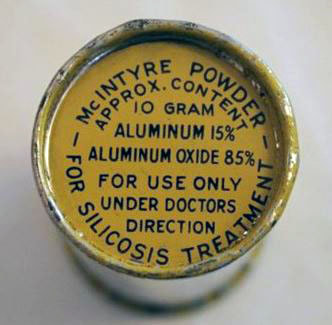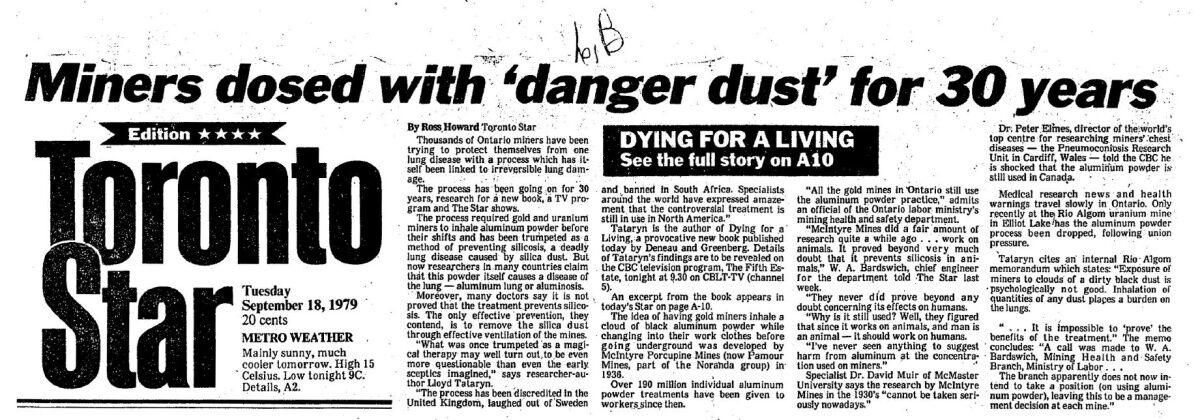Technological advances and regulations brought in by the passing of the Ontario Occupational Health and Safety Act have reduced the health risks that underground miners are exposed to. However, these are three common health risks miners have experienced throughout history.
Silicosis
Silicosis is a form of lung disease caused by exposure to and breathing in silica dust. Scar tissue forms in the lungs, making them less elastic and it becomes harder to breathe. When symptoms appear depends on level and length of exposure. Quartz is a common source of silica and the dust created by drilling it put miners at risk for developing silicosis.
Silicosis
Silicosis is a form of lung disease caused by exposure to and breathing in silica dust. Scar tissue forms in the lungs, making them less elastic and it becomes harder to breathe. When symptoms appear depends on level and length of exposure. Quartz is a common source of silica and the dust created by drilling it put miners at risk for developing silicosis.
|
The mining industry and provincial government have taken silicosis very seriously throughout history. In 1928 lung tests became mandatory and miners had to carry a certificate verifying their lung health. Northern Ontario mines used McIntyre Powder (finely ground aluminum oxide powder) to prevent silicosis from 1944 to 1980. Created by the McInytre Research Foundation on behalf of McIntyre Porcupine Mines, miners breathed in fine aluminum powder for several minutes before going underground. However, the validity of this ‘treatment’ was questionable and may have caused the development of health problems like neurological issues later in life. It is more likely that improved ventilation and the introduction of wet drilling reduced silica dust exposure. In 2020, a study was published about the correlation between McIntyre Powder and neurological diseases. As of February 2022, WSIB recognizes that Parkinson’s disease resulting from occupational exposure to McIntryre Powder as an occupational hazard.
https://www.wsib.ca/en/mcintyre-powder-update |
Source: "Dying for a Living" by Ross Howard, Toronto Star (Sept 18, 1979).
|
Vibration White Finger (VWF)
More commonly known as white finger or white hand, VWF is one of the most common occupational health risks miners experience. VWF is a circulation condition caused by years of working with vibrating tools like drills. The vibration damages blood vessels in the fingers, causing them to restrict blood flow during periods of stress or when cold. During an episode of VWF, the affected fingers will become white.
Mining companies have introduced equipment like drilling machines to limit vibration exposure. Today, companies like Goldcorp are working towards fully automating underground mining, further reducing vibration exposure.
Hearing Loss
Today, miners wear hardhats with ear protection, but that was not always the case. Historically, miners worked in an incredibly loud environment with nothing more than cotton batting or toilet paper in their ears, if anything at all. Continued exposure to loud noises ultimately caused hearing loss. Hearing tests eventually became part of physical exams performed to monitor the health of mine workers. Today, mines have noise-induced hearing loss prevention protocols in place.
More commonly known as white finger or white hand, VWF is one of the most common occupational health risks miners experience. VWF is a circulation condition caused by years of working with vibrating tools like drills. The vibration damages blood vessels in the fingers, causing them to restrict blood flow during periods of stress or when cold. During an episode of VWF, the affected fingers will become white.
Mining companies have introduced equipment like drilling machines to limit vibration exposure. Today, companies like Goldcorp are working towards fully automating underground mining, further reducing vibration exposure.
Hearing Loss
Today, miners wear hardhats with ear protection, but that was not always the case. Historically, miners worked in an incredibly loud environment with nothing more than cotton batting or toilet paper in their ears, if anything at all. Continued exposure to loud noises ultimately caused hearing loss. Hearing tests eventually became part of physical exams performed to monitor the health of mine workers. Today, mines have noise-induced hearing loss prevention protocols in place.
Timeline
Historic Red Lake Mining
Red Lake Geology
The Red Lake Gold Rushes
From Hudson to Headframe
Community Development
Commerce
Education
Medicine
Recreation
Mining Practices
Going Underground
Equipment
Extraction
Milling
The Mill Process
Safety
Refuge Station
Mine Rescue
Health Issues
Jobs
Contemporary Red Lake Mining
Environment
Labour
Innovation
Exploration
Indigenous Rights
Gold Prices
Mining and Exploration Companies
Goldcorp Inc.
Rubicon Minerals
Premier Gold Mines
Pure Gold Mining
Rimini Exploration & Consulting
Other Mining & Exploration Companies
Glossary


